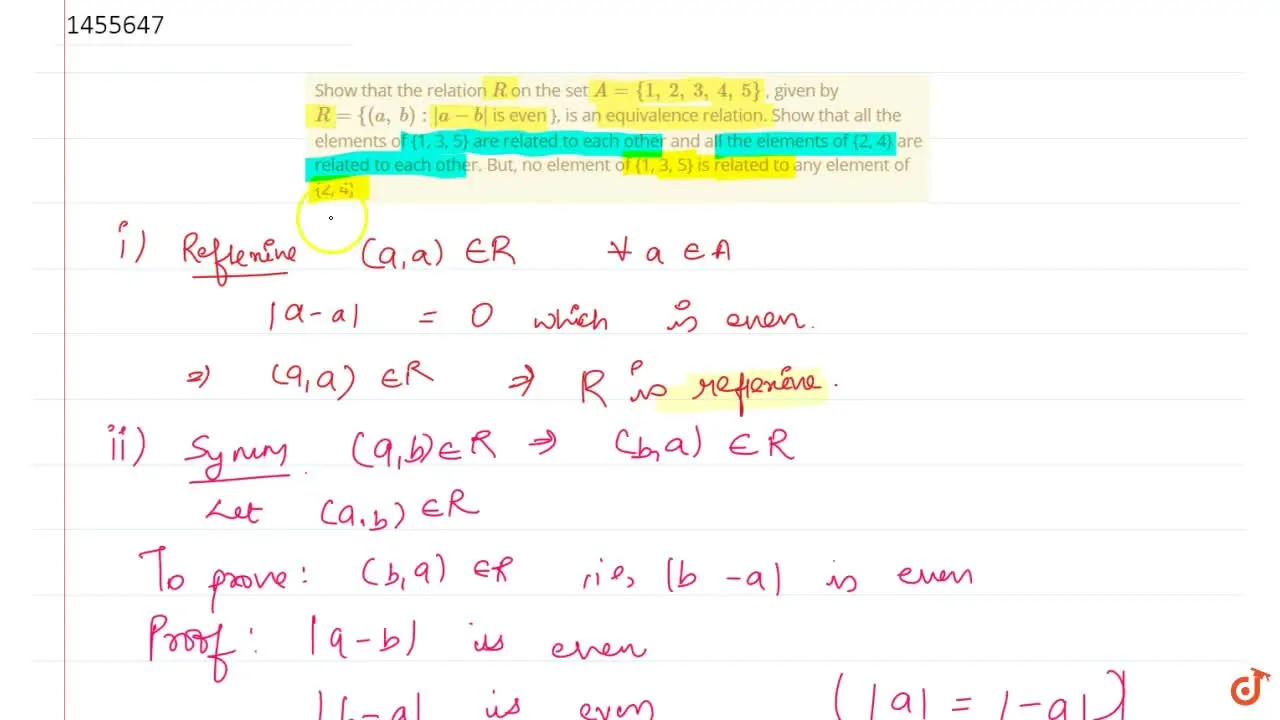Show that the relation R on the set A={1, 2, 3, 4, 5} , given by R={a b|a−b∣ is even }, is an equivalence relation. Show that all the elements of {1, 3, 5} are related to each other and all the elements of {2, 4} are related to each other. But, no element of {1, 3, 5} is related to any element of {2, 4}.
$$
\begin{aligned}
&A=\{1,2,3,4,5\} \\
&R= \begin{cases}a ,& b:|a-b| \text { is even }\}\end{cases}
\end{aligned}
$$
It is clear that for any element a∈A, we have |a−a|=0 (which is even).
∴R is reflexive.
Let (a,b)∈R.
⇒|a−b| is even
⇒|−(a−b)|=|b−a| is also even
⇒(b,a)∈R
∴R is symmetric.
Now, let (a,b)∈R and (b,c)∈R.
⇒|a−b| is even and |b−c| is even
⇒(a−b) is even and (b−c) is even
⇒(a−c)=(a−b)+(b−c) is even [Sum of two even integer is even]
=>|a−c| is even
∴ R is transitive.
Hence, R is an equivalence relation.
Now, all elements of the set {1,3,5} are related to each other as all the elements of this subset are odd. Thus, the modulus of the difference between any two elements will be even.
Similarly, all elements of the set {2,4} are related to each other as all the elements of this subset are even.
Also, no element of the subset {1,3,5} can be related to any element of {2,4} as all elements of {1,3,5} are odd and all elements of {2,4} are even. Thus, the modulus of the difference between the two elements (from each of these two subsets) will not be even.
Related Playlists
Similar Questions
Show that the relation R in the set A={1,2,3,4,5,6,7}given by R={(a,b):|a−b| is even}, is an equivalence relation.
View SolutionShow that the relation R in the set A={1,2,3,4,5} given by R={ab|a−b∣ is even }, is an equivalence relation.
View Solutionshow that R is an equivaence relation R defined on the set S={1,2,3,4,5} given by R={ab|a−b∣ is even } is an equivalence relation .
View SolutionProve that the relation R in the set A={1,2,3,4,5,6,7} given by R={ab|a−b∣iseven} is an equivalence relation.
View SolutionShow that the relation R in the set A = {1, 2, 3, 4, 5} given by R = {(a, b) : |a – b| is divisible by 2} is an equivalence relation. Write all the quivalence classes of R.
View SolutionShow that the relation R in the set A={x∈N:0≤x≤12} given by R={(a,b):|a-b| is a multiple of4} is an equivalence relation?
View SolutionThe relation R in the set A = {1,2,3,4,5} is given by R = {(a,b) : |a - b| is even} is a/an
View SolutionLet R be the relation defined on the set A={1, 2, 3, 4, 5, 6, 7} by R={(a, b): both a and b are either odd or even}. Show that R is an equivalence relation. Further, show that all the elements of the subset {1, 3, 5, 7} are related to each other and all the elements of the subset {2, 4, 6} are related to each other, but no element of the subset {1, 3, 5, 7} is related to any element of the subset {2, 4, 6}.
View SolutionShow that the relation R in the set A={x:x∈N,x≤10} given by R={(a,b):a+b is even number] is an equivalence relation. Also find the set of all elements related to 3
View SolutionProve that the relation R in the set A={5,6,7,8,9} given by R={ab|a−b∣, is divisible by 2}, is an equivalence relation. Find all elements related to the element 6.
View Solution


